
views
Preparing for the Bath

Understand when to bathe ferrets. Many ferret owners love their pets but get frustrated by their smell, which can be quite strong. Bathing ferrets can be a good way to combat odor, but only if it's done following proper protocol. Bathing a ferret too often can actually make the smell worse. Bathing strips oils from a ferret's skin and oil glands go into overdrive to replace what's been lost. This result in added stink. Ferrets should not be bathed more than once a month. Ferret smells are actually more often related to a ferret's bedding, cage, and blankets than to the ferret itself. Try washing these items before bathing your ferret to rule them out as the primary cause of smell. Ferrets become itchy and uncomfortable when bathed too often. If your ferret is itching frequently and appears otherwise distressed, you might want to cut back on how often you're bathing him.

Choose the right supplies. All your supplies should be ready before you bring your ferret to the tub or sink. To bathe a ferret, you will need: Shampoo. Choose a shampoo specifically made for ferrets. Shampoos made for other animals can easily dry out a ferrets skin and cause him discomfort. Depending on your ferret's needs, choose a shampoo right for him. If he's not well behaved during bathing, for example, get tearless shampoo in case shampoo gets in his eyes. If he has fleas, special shampoos that kill flees are available. Ferret shampoo can be purchased online or from a pet store. If you want, you get conditioner for your ferret. This replenishes the oils lost in bathing. Once again, be sure to select a conditioner specifically made for ferrets. A towel should be available to dry the ferret after the bath. Ferrets get cold quickly, so you may want to put the towel in the dryer before the bath so it's warm to the touch afterwards.
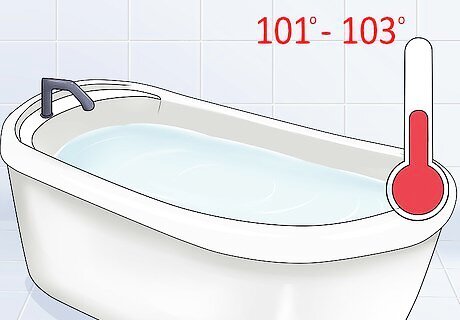
Make sure the water temperature is okay. A ferret's normal body temperature is between 101 and 103 degrees Fahrenheit. Water that feels lukewarm to you is cold for a ferret. Fill the tub or sink with water that is warm to the touch but not boiling. Go for the water temperature you would want when taking a hot bath.
Bathing the Ferret
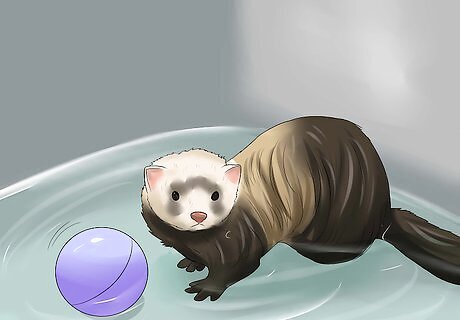
Keep the ferret comfortable. Before lowering your ferret into the tub or sink, make sure he is comfortable. This way, he'll be less nervous during the actual bath. Any time you hold your ferret, support his body completely. Make sure his feet are resting on the floor and, if they're not, make sure your hands are supporting his feet. Make sure the water is not too deep. Hold the ferret up above water if he seems distressed and let the water drain some until he is relaxed. Ideally, your ferret should only be submerged up to his chest. Your ferret's feet may slip on the floor of a bath or sink. Consider a rubber matt to make sure he can stand steady and therefore feel safe. Having some of your ferrets favorite toys in the water can help him relax during bath time.
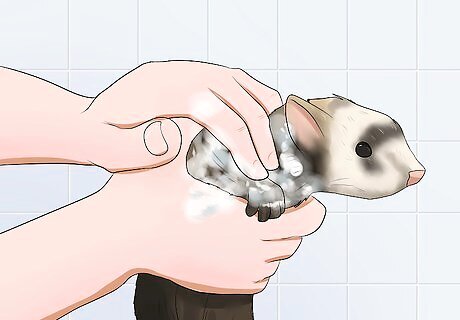
Shampoo the ferret. After getting your ferret in the water, you can begin the process of shampooing the ferret. First, get your ferret thoroughly wet. You can do this by gently splashing water on his sides, running the faucet over him, or using a measure cup to pour water of his back, head, and tail. Run the shampoo bottle under warm water before applying it to your ferret's skin. Ferrets get cold easily and you want to make sure the shampoo is slightly hotter than room temperature. Apply a thin line of shampoo down your ferret's back and massage the shampoo deep into the ferret's coat. Be particularly diligent about washing his tail and abdomen, as these are areas where oils build up and increase odor. Be careful to not get soap in the ferret's eyes or mouth. Only use your fingertips when washing around the head to reduce the likelihood of this happening. Keep one hand on your ferret while you wash him to make sure he doesn't move around too much, which can cause injury to you via biting and scratching. If you're choosing to condition the ferret's coat, repeat this process with conditioner after rinsing the shampoo from the ferret's coat.
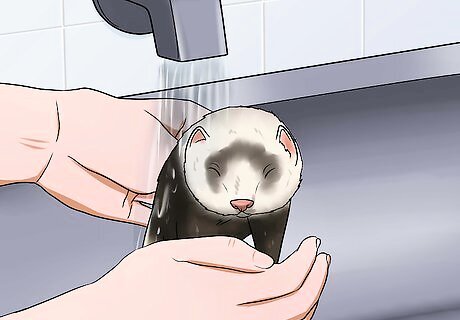
Rinse you ferret thoroughly. Leaving shampoo in can cause your ferret's skin to dry out. Make sure to get all the shampoo out before letting your ferret out of the bath. If you're bathing your ferret in standing water, drain the tub before beginning the rinsing process. The water is likely diluted with shampoo, hair, and debris and it's counterintuitive to use it to rinse the ferret. Refill the tub with fresh water, once again making sure it's hot to the touch. Use this water to work shampoo out of your ferret's coat. Rinse the head carefully with your hand. Do not pour water directly on his head as you do not want soap to run into his eyes. If possible, use a faucet during the rinsing process as this can help work shampoo out of the ferret's fur. Do not take the ferret out of the bath until no soap residue surfaces when water is being poured over his coat.
Drying Your Ferret
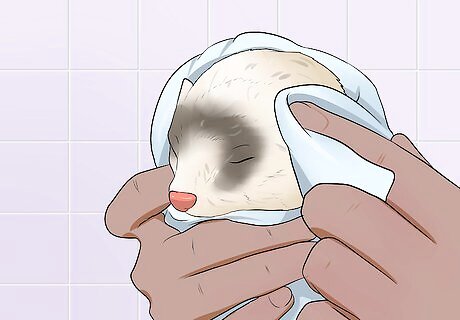
Use a towel to begin drying the ferret. Ferrets are often aggravated after a bath and desperate to get dry. As you don't want a sopping wet ferret running around, begin the drying process with a clean towel. Wrap the ferret in a towel and attempt to rub his fur. Be gentle. Your ferret is probably aggravated, so be gentle and do not attempt to dry him for too long. Expect that your ferret will not tolerate too much drying. Ferrets crave space after a bath. If the ferret is being particularly difficult and resisting being dried, let him go. You do not need to get him completely dry. Just make sure he is not sopping.
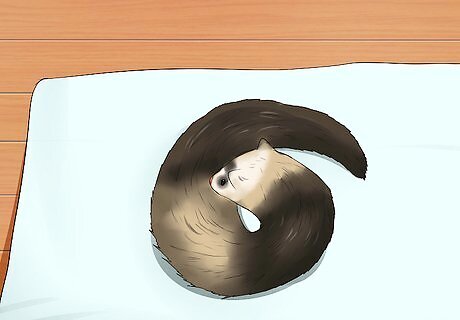
Allow ferrets to dry themselves. After the bath, ferrets will want to try to dry themselves by rubbing their fur on warm, dry surfaces. Pick a designated drying space for your ferret, and lay down clean towels and blankets for him to use. You should keep the ferret in a contained area during the drying process. He might roll or rub on a dirty surface, meaning he'll need another bath. Do not be alarmed. Many ferret owners are surprised by the erratic movements of a ferret after a bath, but this is normal ferret behavior and not a cause for concern.
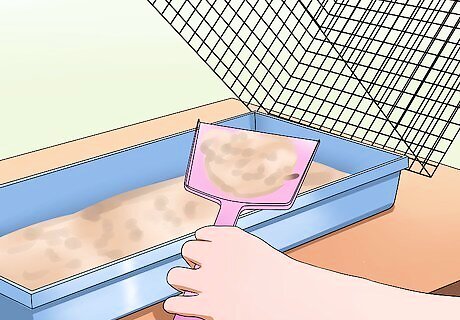
Make sure the ferret's cage and litter are clean. Bathing ferrets provides a good opportunity to clean their blankets and cages. Make sure clean linen is available right after a bath, and make sure your ferrets litter box is clean. Ferrets often want to relieve themselves right after a bath, and might be wary to do so in a dirty litter box.




















Comments
0 comment